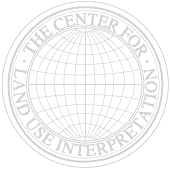Center for Land Use Interpretation

The Center for Land Use Interpretation (CLUI)[1] is a non-profit research organization, based on Venice Boulevard in the Westside Palms neighborhood of the city of Los Angeles, in southern California.
Background
The Center for Land Use Interpretation (CLUI) was founded in 1994 by Matthew Coolidge, and is a non-profit research and education organization that involves exploring, examining, and understanding land and landscape issues. The Center employs a variety of methods to this end, engaging in research, classification, extrapolation, and exhibition. The mission statement of the CLUI is to "increase and diffuse knowledge about how the nation's lands are apportioned, utilized, and perceived."[2] The organization produces exhibitions about land use phenomenology in the USA, and displays them at its exhibit locations and at other museum and non-commercial and educational venues as well. The CLUI produces publications, online resources, tours, lectures, and other public programs across the country. Activities of the Center are summarized and discussed in its annual newsletter, The Lay of the Land, available in print to subscribers as well as online. The CLUI's main office is in Los Angeles, on Venice Boulevard, across from downtown Culver City, where it operates a display space open to the public.[3] It also operates other facilities and interpretive sites in the USA. CLUI is also the lead agency for the establishment of the American Land Museum, a network of exhibition sites in various interpretive zones across the country, which together form a dynamic portrait of the national landscape. According to Coolidge, the "man made landscape is a cultural inscription that can help us better understand who we are and what we are doing."[4]
Neither an environmental organization nor an artist collective, CLUI resists categorization by maintaining a diverse, eclectic program of activities that invite a closer examination of "humankind's interaction with the Earth's surface." Writer and curator Lucy Lippard suggests the CLUI occupies “a tantalizing liminal space (that) has opened up between disciplines, between the arts, geography, history, archeology, sociology.” [5] Culture writer Doug Harvey calls the Center, known for its “multidisciplinary examinations of human/landscape interaction, 'uncategorizable'.” [6] He refers to CLUI programs, such as the 2008 Post Consumed exhibit and bus tour as “subtly infused with formal beauty and wit…unobtrusively informed by a patchwork of art historical, contemporary theoretical, sociological and geopolitical concerns and brimming with new information you don’t know is here until the ride home.”[7]
According to Los Angeles Times architecture critic Christopher Hawthorne, the CLUI's activities “all tell some version of the same story: how we shape and find meaning in the physical landscape around us, whether it’s through oil exploration, architecture, map-making or freeway building.”[8] The CLUI specializes in what writer Nicola Twilley describes as a “brand of perceptual revelation”–“in which a previously overlooked site is made not only visible, but also legible as a guide to understanding larger, nationwide systems.”[9]
Programs and projects
The CLUI also executes exhibitions, research projects, and public programs. The Center's programs and projects cover many types of land uses in the USA, including those related to agriculture, energy, industry, mining, communication, waste management, water resources, transportation, commerce, housing, recreation, and defense and preparedness.
Online resources
The CLUI makes a collection of "unusual and exemplary" land use sites in the United States available online, through the Land Use Database. Site-specific images in the database are taken by members of the CLUI, and are attributed to the CLUI Photo Archive. Another archive of non-site-specific images taken by members of the CLUI, known as the Morgan Cowles Archive, is also available online.
References
- ↑ "The Center for Land Use Interpretation". clui.org. Retrieved 2015-11-25.
- ↑ "About the Center". The Center for Land Use Interpretation. Retrieved August 15, 2018.
- ↑ "The Administrative Sublime, or The Center for Land Use Interpretation". Afterall Journal. 2006. Retrieved August 15, 2018.
- ↑ "Matthew Coolidge-CLUI". Knowlton School, Ohio State University. October 2011.
- ↑ "Lucy Lippard, Imagine Being Here Now: Towards a Multicentered Exhibition Process". The Falmouth Convention. May 2010. Retrieved September 27, 2016.
- ↑ "Doug Harvey, The Big Nowhere". LA Weekly. November 1999. Retrieved September 27, 2016.
- ↑ "Doug Harvey, Wading in the Waste Stream with the Center for Land Use Interpretation". LA Weekly. August 2008. Retrieved September 27, 2016.
- ↑ "Christopher Hawthorne, Architecture review: 'Centers of the USA' at the Center for Land Use Interpretation". Los Angeles Times. January 2012. Retrieved September 27, 2016.
- ↑ "Nicola Twilley, Finding Tarzan at the Sanitation Department". Good Magazine. April 2011. Retrieved September 27, 2016.